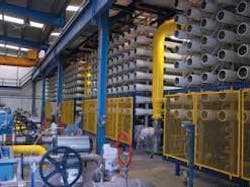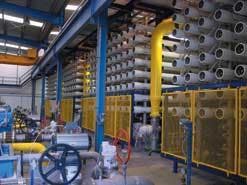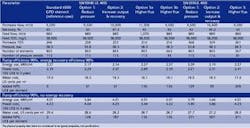Economics of desalination — reducing costs by lowering energy use
By Markus Busch, Bill Mickols
Cost reductions resulting from improved seawater reverse osmosis (SWRO) technology have made seawater desalination a more economical and attractive alternative for supplying drinking water in regions of the world with limited fresh water resources.
In the early 1980s, a desalination plant on the island of Malta operating at 30% to 33% recovery produced water at a cost of US$ 1.08 per m3. By the late 1990s, however, RO mem-branes with higher flow rates and higher rejections helped reduce the cost of desalination to an estimated US$ 0.73 per m3. More recent cost proposals, such as for the Ashkelon desalination project in Israel, have included costs as low as US$0.52 per m3.
Operation costs account for two-thirds of water production costs, while one-third is based on capital cost depreciation. Energy accounts for 50% of the operation cost when membranes, pumps and energy recovery devices with standard efficiency are used.
Basic thermodynamics explains the inherent energy cost of producing potable water from seawater. These analyses use second-law considerations to estimate inefficiencies from concentration differences and from converting one stream into two streams at different thermodynamic states. Calculations show that the minimum energy needed for 38,000 mg/L of seawater at 45% recovery with a product water of 300 ppm is 2.1 kJ/kg of permeate, which corresponds to a usage of 0.6 kWh/m3. However, the historical energy consumption of seawater plants has been in the range of 2.5 kWh/m3 to 4 kWh/m3, or four to six times higher than the thermodynamic requirement.
This energy loss is due to different factors:
• Inefficiency of feed pump and motor;
• Water permeating through the membrane;
• Energy lost with brine.
Even if the system used 100% efficient pumps, motors and energy recovery, the energy required to permeate water through conventional membranes adds 1.1 kWh/m3 to the thermodynamic requirement of 0.6 kWh/m3, which triples the energy requirement! With pressurised brine, the system can lose between 0.1 and 1.9 kWh/m3, depending on the use of energy recovery devices and their efficiency (e ER). Depending on pump efficiency, the system can lose an additional 0.4 to 1.6 kWh/m3.
Consequently, efficiency increases in pump, motor and energy recovery devices lead to considerable energy savings. The largest fraction of energy use is the permeation of water through the membrane. To minimise energy consumption and reach levels as low as 2.0 kWh/m3, elements with higher productivity, which can also reduce other costs, such as the pretreatment or capital cost, are needed.
A new generation of SWRO membranes enables further cost reduction through high fouling resistance, increased productivity and rejection, and improved cleanability. The savings depends on site conditions and permeate quality requirements.
Designing systems around high-flow, low-energy elements can enable significant reductions in capital expense (CAPEX), operational expense (OPEX) or both.
To reduce capital expense, designers can use the membranes' higher productivity to increase capacity using the same number of pressure vessels and membrane elements, or use fewer pressure vessels and membrane elements for the same capacity.
To reduce operating expense, the feed pressure can be reduced while using the same number of elements to achieve the same flow rate, resulting in lower energy costs at lower flux.
To reduce both capital and operating expense, water production and recovery can be increased using the same number of membranes, resulting in lower pump and pre-treatment capital and operating costs.
Table 1 shows the typical pressure, recovery, permeate flow rate and costs of a plant using high-flow, low-energy FilmTec SW30XLE-400i and SW30HR LE-400i elements, as compared to standard 6000 gpd elements.
The plant operates on a feed with 38,000 mg/L at 25ºC. The design is 115 vessels with seven elements per pressure vessel, and a vessel produces 3.45 m3/h. Overall, the production of the plant is 9,500 m3/d. The average flux is 14.0 L/m2h; recovery is 45%.
The cost of the membrane stage will be evaluated, including the energy cost during five years of operation ("power cost") and amortisation of the investment cost for pressure vessels and membrane elements ("capital cost"). The real plant costs will be higher after adding the cost of the site, racks, buildings, intake, pre- and post-treatment system, chemicals, etc. However, since the influence of high productivity elements on cost items outside the membrane stage are more indirect, they will not be considered.
Assume the following:
• Operation time: 5 years
• Replacement rate: 20%
• Pump efficiency: 90%
• Power cost: US$0.08/kWh
Table 1 includes two scenarios, one with energy recovery devices (90% efficiency), and one without. In addition to the power and capital costs, the value per element of converting the plant to the new designs with new elements will be calculated. The added value per element corresponds to the power and capital cost savings after replacing the conventional 6,000 gpd elements.
Whether operating pressure is reduced or output and recovery are increased using FilmTec SW30HR LE-400i elements, the permeate quality (253-258 mg/L) stays roughly the same as with 6000 gpd elements, at 99.70% product (248 mg/L). The permeate quality, however, is improved by 13% to 216 mg/L when using higher output at recovery of 45%.
Using FilmTec SW30XLE-400i elements, the permeate TDS is still well below the World Health Organisation (WHO) 550-ppm limit (359-368 mg/L) in the case of reducing operating pressure or increasing output and recovery. In the case of operating at high output and the original recovery, the permeate concentration increases slightly, from 248 to 261 mg/L.
All of the scenarios meet a drinking water quality of 500 mg/L and offer a safety buffer of at least 27% for post-treatment and/or variation of operating conditions.
Option 1: Reduce operating pressure.
Operating pressure can be reduced by 2.5 bar using FilmTec SW30HR LE-400i elements or 4.5 bar using FilmTec SW30XLE-400i elements, corresponding to four to eight percent energy reductions. With high efficiency motors, pumps and energy recovery, energy consumption could reach 2.09 kWh/m3. A lower flux design enables even lower consumption, below 2.0 kWh/m3. Note that operating higher productivity elements at lower pressure to match the design flow of lower productivity elements may result in increased permeate salt concentration.
With SW30HR LE-400i elements, the savings is US$ 0.05 per m3 with recovery and US$.01 without recovery. Savings are higher with SW30XLE-400i elements: US$.01 per m3 (with energy recovery) and US$ .019 (without recovery). The added value is between US$61 (SW30HR LE-400i elements with energy recovery) and US$231 per element (SW30XLE-400i elements without energy recovery); therefore, the user will break even as long as the price delta is below these limits.
For greater reductions in operating expenses, we could modify the scenario to a longer project lifetime (e.g., 10 years instead of 5), a lower replacement rate (10% instead of 20%) and use of energy recovery. The water cost then drops from 13.6 to 12.7 US cents per m3, and the operational cost savings per element is US$227.
Option 2: Increase output and recovery.
Water production and recovery are increased to achieve savings in capital and operating costs. Higher water production means capital savings in pressure vessels and elements; higher recovery means reduced capital cost in pre-treatment and reduced operation cost for pumping and pre-treatment. Note that increasing average flux and recovery may result in changes to permeate quality, fouling behaviour and scaling potential.
With SW30HR LE-400i elements, the added value per element is US$ 61 with energy recovery and US$ 187 without recovery. The operational cost savings per element is US$ 95 with energy recovery and US$ 307 without recovery when using SW30XLE-400i elements.
Option 3: Reduce number of elements and pressure vessels and operate at higher flux.
The number of pressure vessels and elements can be reduced by 17% using SW30HR LE-400i elements or by 30% using SW30XLE-400i elements. This corresponds to a reduction in water cost of US$ .09 per m3 (operational cost savings of US$ 136 per element) using SW30HR LE-400i elements and US$ .016 per m3 (US$ 260 per element) using SW30XLE-400i elements. Note that increasing average flux at the same recovery reduces salt passage, creating a good option for improved permeate quality.
Alternately, the same number of pressure vessels could be used (115) to increase water production. In this case, the savings would be the same as when reducing the number of elements.
Conclusion
Apart from higher efficiency pumps and energy recovery devices, enhancements in productivity and rejection of SWRO elements have led to significant reductions in energy consumption from 3-4 kWh/m3 to a potential 2.0 kWh/m3. High productivity, high rejection elements also enable savings in capital costs, and can be used to reduce intake and pretreatment costs when recovery is increased.
Authors' NoteMarkus Busch is the seawater technology platform manager for The Dow Chemical Company, based in Midland, Michigan, USA. Bill Mickols, Ph.D., is a senior research and development scientist at The Dow Chemical Company.


